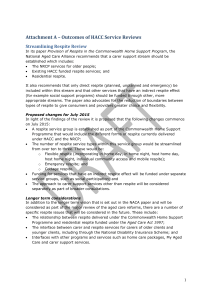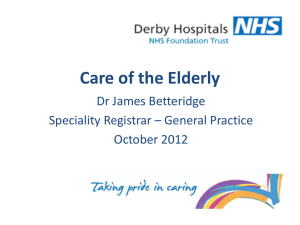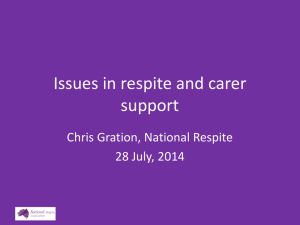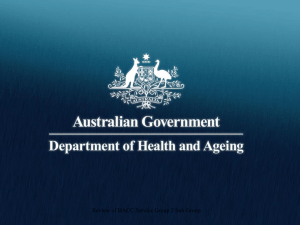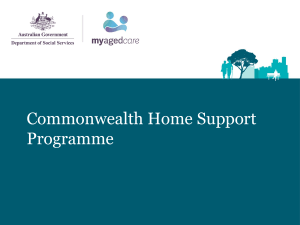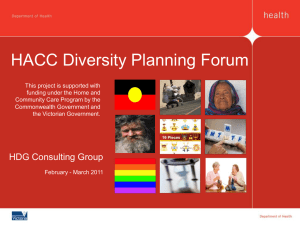The Future of Respite in Aged Care
advertisement
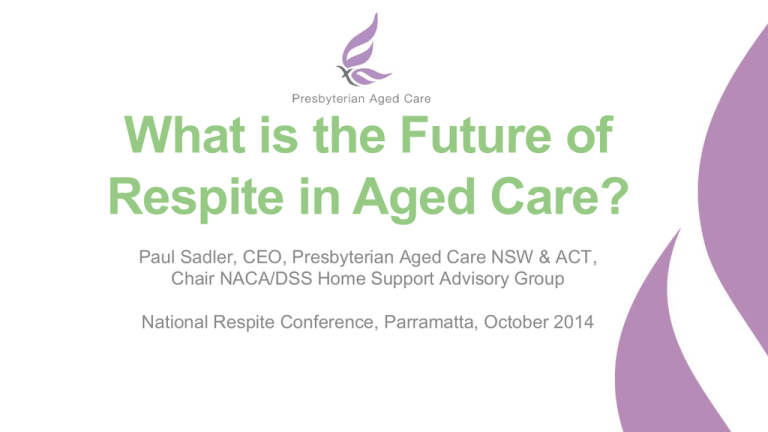
What is the Future of Respite in Aged Care? Paul Sadler, CEO, Presbyterian Aged Care NSW & ACT, Chair NACA/DSS Home Support Advisory Group National Respite Conference, Parramatta, October 2014 2 Respite & Aged Care 1. Aged Care Reform history a) Productivity Commission inquiry b) Living Longer Living Better c) Coalition Government policy 2. Key components of aged care reform a) My Aged Care Gateway b) Quality Arrangements c) Home Care Packages 3. Commonwealth Home Support Program 4. Implications for Respite 3 The Productivity Commission Report August 2011 Focus: Wellbeing of older Australians – promoting their independence, giving them choice and retaining their community engagement Balance: • Individual responsibility • Affordability for taxpayers • Safety net for those that need it 4 Living Longer Living Better • Released by Prime Minister 20 April 2012 • Complemented: • Health Reforms • National Disability Insurance Scheme (NDIS) • Response to Report on Economic Potential of Senior Australians 5 Key Features of LLLB Reforms • $3.7 billion package over 5 years (2012-2017) • Only $577m new funding • $1.6 billion taken from Aged Care Funding Instrument (ACFI) cuts in residential care • Other measures, such as dementia supplements, funded by reducing basic subsidies • Marks further policy shift towards home care • Greater emphasis on user pays • 5 Acts passed Federal Parliament June 2013 to enact aspects of Living Longer Living Better reforms • Guide to Aged Care Law released September 2014 • http://guides.dss.gov.au/guide-aged-care-law 6 7 Now the Aged Care Policy • 5-year Healthy Life, Better Ageing Agreement • Based on PC Caring for Older Australians report and LLLB reforms • Negotiated with key stakeholders via Aged Care Sector Committee • Cut red tape • So far removal of Federal building certification requirement • Put $1.5 billion for Workforce Supplement back into general aged care funding • 2.4% increase in aged care subsidies and community programs from 1 July 2014 • $200 million for dementia research • Aged care transferred from Department of Health & Ageing to Department of Social Services 8 Aged Care: NDIS comparison Aged Care NDIS Applies to people gaining disability aged 65+ Applies to people gaining disability before age 65 Individual budget only in HCP, with CDC budget handled by provider Only individual budgets controlled by NDIA and person with a disability Block funding remains in HACC Limited block funding in trial sites Residential care remains, but reducing as proportion of aged care Transition away from institutional care Substantial co-contribution required with use of home asset for residential care; government funds safety net from general taxation No co-contributions but choice to pay for extra services; mainly funded via 0.5% Medicare Levy increase and general taxation Assessments by mix of ACATs, My Aged Care and service providers Assessments by NDIA 9 Aged Care Gateway • My Aged Care website and national call centre • New regional assessment services for home support services • Tender expected shortly • ACATs remain for access to Home Care Packages or residential care • Electronic client record from mid 2015 • Initially in assessment services and call centre • Further trial of assessment tool around March/April 2015 • Linking service for people with multiple needs 10 Quality Arrangements • Australian Aged Care Quality Agency • Assumed responsibility for home care on 1 July 2014 • • • • Aged Care Commissioner powers strengthened National Aged Care Advocacy Program boosted by 20% Community Visitors Scheme expanded Quality indicators eventually onto My Aged Care website 11 Home Care Packages • Home Care packages (HCP) adjusted up from 25 to 45 places per 1,000 people 70+ • Additional 84,538 Home Care packages over 10 years • 2 new levels of Home Care package (piloted over 2013-2015) Home Care Package Annual Subsidy Level (2013-14) Level 1 $7,501 Level 2 (formerly CACP) $13,644 Level 3 $30,003 Level 4 (formerly EACH) $45,607 • Movement from HCP levels 1/2 to 3/4 requires ACAT assessment • All Home Care packages to be converted to Consumer Directed Care from July 2015 12 Home Care Packages • Dementia and Cognition Supplement for all HCP levels • 10% of basic subsidy funded by 2% reduction of CACP and EACH from 1 July 2013 • Estimated 26% of clients will qualify • 54% of veterans, with mental health condition verified by DVA, will attract Veterans Supplement • User charges from 1 July 2014 • Basic fee of 17.5% of Age Pension retained • Income tested fee introduced, reducing subsidy payment • Annual cap of up to $10,000 and lifetime cap of $60,000 on income-tested care fees • Hardship provision available 13 Home Support Program • Commonwealth Home Support Program (CHSP) to replace HACC, NRCP, DTC and ACHA from 1 July 2015 • Regular annual growth for HACC likely each year, and all elements of Home Support Program from July 2015 • 2014 Federal Budget has reduced future growth to 3.5% per annum • No change to HACC services until 2015 • Reviews of some HACC service types during 2013 / early 2014 • • • • • Respite care Home modifications and maintenance Meals Community transport Service Group 2 (assessment, case management, etc) 14 NACA Home Support Advisory Group Representation • NACA mix of providers, consumers, unions and professionals • Complemented by State & Local Government, specific HACC service type providers • ACSA represented by Carole Bain (Silver Chain, WA) Purpose • Provide advice on establishment of Commonwealth Home Support Program • Have released: • Discussion paper on design of CHSP • Discussion paper on place of respite in CHSP 15 16 17 Commonwealth Home Support Program • DSS has released Commonwealth Home Support Program (CHSP) Discussion Paper http://www.dss.gov.au/our-responsibilities/ageing-and-agedcare/aged-care-reform/reforms-by-topic/commonwealth-homesupport-programme • Reviews of HACC service types are also published on website • DSS is working with HSP Advisory Group on Program Guidelines and Program Manual • Anticipate opportunity for further comment on these documents later in 2014 • Sub-Group working on CHSP Fees Policy 18 Comparison NACA / DSS NACA Area DSS proposal Comment Program Design (Vision) ✖ No single program; no individualised funding Goal (Aim) ✔ Target Group & Eligibility ✔ Some concern re “basic support” Principles ✖ Not articulated as such Service streams ✔ Except meals and transport stay separate Reablement / wellness ✔ Consumer direction ✔ Only partial without individual budgets Transition ✔ Key areas acknowledged 19 CHSP Key Directions • It is proposed that the CHSP will: • provide timely, basic home support services to frail older people and their carers, to help them remain living independently in the community - with people requiring higher levels of care eligible for Home Care Packages or residential aged care; • streamline the home support system in order to cut red tape for providers and improve access for clients; • increase sustainability through a more consistent approach to client fees; • be underpinned by a wellness and reablement philosophy; • be accessed through My Aged Care; and • continue to build, and be informed by, a robust evidence base. 20 CHSP: Consolidated Basic Support Program • This will enable more older people to be able to access the care and respite services they need. Clients with more complex needs will be supported to transition over time to more appropriate levels of care such as Home Care Packages. • There will be continuity for most service types, with some changes and consolidation based on the outcomes of service reviews conducted during 2013-14. Service providers will be funded based on output based block funding from 1 July 2015. • Greater contestability will be introduced to ensure that client outcomes are maximised and that value for money is achieved. • The amalgamation of three community aged care programmes and clarification of programme boundaries, such as a single set of eligibility criteria, will reduce administrative burden for service providers and improve client outcomes by providing more consistent and integrated care. 21 NACA CHSP Design Service Streams Service/Outcome Stream Existing Service Types within the new streams Social Participation and Access Social Support, Centre Based Day Care, Community Visitors Scheme, and Transport Health and Wellness Allied Heath services, Home Modifications, Goods and Equipment, Reablement, Massage, Nursing Services, Personal Care, Personal Services (hygiene), Meals, other Meal and Food Services and Day Therapy Centres Carer Support HACC Respite, In-Home day Respite, In-home Overnight Respite, Community AccessIndividual, Community Access-Group, Host Family Day/Overnight Respite, HACC Counselling (for carers), Overnight Community Respite, Mobile Respite, Other Respite, and Residential Respite Household Maintenance Domestic Assistance, Home Maintenance, Gardening and Linen Service Innovation and System Resourcing Service innovation and system resourcing not covered in the above streams including management of contracted/brokered services, system supports (e.g. training and development roles, aged services workers), etc. 22 23 24 NACA Respite Recommendations • Create Carer Support Stream incorporating NRCP, HACC respite and carer support, and residential care respite • Services with a respite effect but other major focus (e.g. centrebased day care) shouldn’t be in this stream • Consumer direction philosophy should underpin service delivery • Streamlining of emergency respite access • Expansion of flexible respite, especially for working carers and special needs groups • Limit on amount of respite available per person 25 • Effective linkages with Home Care Packages, Carer Support Centres and Aged Care Gateway CHSP: Service Type Review Response • Respite service types streamlined to three • Flexible • In home day, in home night, host home day, host home night, individual community access and mobile respite • Cottage • Emergency • Commonwealth Carer Respite Centres funding • Centre-based day respite, residential day respite and group community access respite are proposed for funding under social participation outcome group as part of centre-based day care 26 Carer Support • LLLB flagged creation of Carer Support Centres • DSS has commenced process to review how carer support might be structured across its portfolio of aged care, disability, mental health • Future of HACC carer support services unclear • Will they transition to CHSP or a new DSS carer support program? • New model in place from July 2015 27 CHSP: Fees • A nationally consistent fees policy will be introduced from 1 July 2015. • For clients this will mean a fairer system where clients of similar means will pay consistent fees (regardless of location) for accessing Commonwealth Home Support Programme services. • For service providers the fee structure will acknowledge the differing cost drivers of service types, for example, home modifications may have a different fee structure to domestic assistance. 28 CHSP: Contestability • Contestability implemented with following considerations: • Transition of Vic and WA HACC services to Commonwealth; • Existing capacity to operate new services and programme infrastructure; • Whether all service types are suitable for tendering (e.g. Meals on Wheels with a high volunteer contribution); • The feasibility of tendering minimally funded services (e.g. where an organisation receives less than $50,000pa); and • Trialling different approaches to contestability (such as ‘cashing out’ respite funds to carers/consumers). • Contestability will apply to: new Regional Assessment Services; 29 Sector Support and Development roles; (most) growth funding CHSP: Transition • Clients with high level needs • People under 65 • NRCP carers of clients under 65 • HACC Service Group 2 • Assessment to My Aged Care • Case management to My Aged Care (short-term) or Home Care Packages (long-term) • • • • Client care coordination removed Client counselling to allied health / therapy Informal counselling, support and information to My Aged Care Advocacy to National Aged Care Advocacy Program 30 Implications for Respite Services • No one’s funding is guaranteed past 30 June 2015 • However, change in aged care is likely to be evolutionary, not revolutionary • While details are still to be settled, scope of home care and home support programs is becoming clear • Respite will be a part of CHSP • Are you ready? • To go it alone? • To partner with another organisation? • To merge if necessary? 31 Useful links National Aged Care Alliance http://www.naca.asn.au Australian Department of Social Services http://www.dss.gov.au/our-responsibilities/ageing-andaged-care Aged & Community Services Australia http://www.agedcare.org.au/ 32
